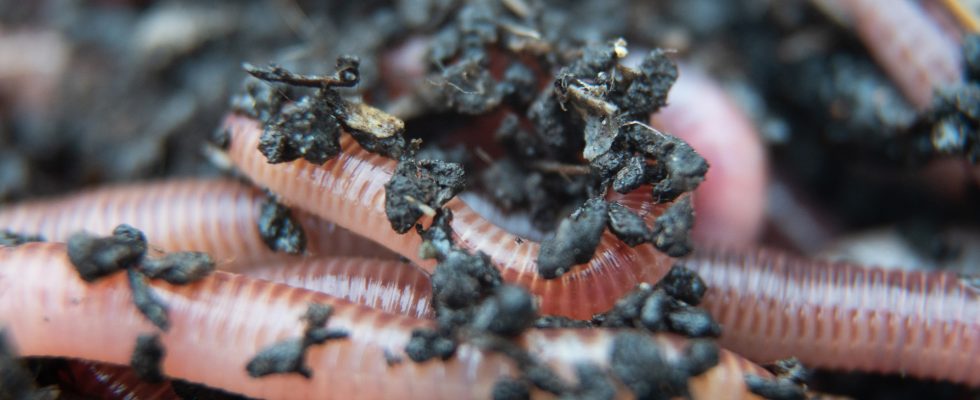Status: 04/11/2023 12:35 p.m
The German forests do not cope well with heat and drought – they would have to be converted into a mixed forest. In a pilot project in Bavaria, earthworms are supposed to help make the forest climate-stable.
Martin Brennauer’s forest will become a forest of the future. On the almost 40 hectares in the Sachsenried forest south of Landsberg am Lech, the spruce cultivated in Bavaria for centuries still predominates. However, Brennauer has already started to convert his forest to make it fit for the climate of the coming decades.
At the moment it is “still good to sell spruce,” he says. With a view to the future, however, other tree species must be included. Because the spruce is already showing its weaknesses: “The temperatures are getting higher, there are dry phases, and then they are very susceptible to the bark beetle, for example.”
“Earthworm-loving species” preferred
Brennauer discusses the next steps with forester Ludwig Pertl from the “Future Forest” project in the district of Landsberg. “We have to turn forests rich in conifers into highly stable permanent forests with mixtures that result in healthy soil,” says Pertl. It’s about “earthworm-loving species”.
In addition, the forests “must remain stable and high so that we can still get enough precipitation during the growing season”. According to Pertl, only if the trees are tall enough does enough evaporating water come back as rain. The worms loosen the soil so that it can also absorb and store the water and also stimulate the formation of humus.
Aim: Manual of the climate-proof forest
Maple and linden, for example, are tree species in whose vicinity earthworms feel comfortable – a finding from the three-year, EU-funded “Future Forest” research project: in several test areas, sensors, so-called dendrometers, directly on the tree trunk document which tree species what weather and on what soil grow particularly well or poorly – in the range of thousandths of a millimeter. The respective stock of earthworms is determined from soil samples in the vicinity of the trees.
At the end there should be a handbook for climate-proof forest conversion. “The handbook will be made available to all communities in the EU. We will also make a condensed, short version that practitioners or anyone interested in forest conversion can read,” says Nikolaus Storz from the Landsberg district office. The point is that the forest can continue to fulfill important ecosystem functions such as cooling and cleaning the air or the formation of new, clean drinking water.
The worm is a decisive factor here: The Bund Deutscher Forstleute, BDF, also recommends that forest owners rely fully on earthworms when converting forests to adapt to the climate.
Premiums for forest conversion
In Fuchstal, the findings are already being put into practice with the pilot project for the forest of the future premium. The municipality pays forest owners up to 400 euros per year and hectare as compensation if they already rely on climate-stable tree species. 26 forest owners with a total of 120 hectares of forest in Fuchstal have been involved in the pilot project so far. The first money should flow in the summer.
Forest owner Brennauer also receives the subsidy: Hundreds of beech trees, one to two meters high, grow in a fenced-in area under the roof of the tall spruce trees that are still numerous. The fence protects the small trees from deer browsing. In an adjacent plot there are already numerous small maples and linden trees. Brennauer finds it important that the municipality “supports them with a bonus, because the forest conversion should also pick up the pace”.
43 million trees planted with grant support
In addition to municipal funding, such as in the municipality of Fuchstal, there are also other funding pots for climate-proof forest conversion. According to the Ministry of Food, Agriculture and Forestry, the Free State of Bavaria, with its more than 2.5 million hectares of forest, has paid out more than 110 million euros for planting in the past four years.
Part of the money comes from a subsidy fund from the Federal Ministry for the Environment. Around 43 million trees were planted with the help of the funding. Forest owners receive up to 100 euros per hectare and year through the federal program “Climate-Adapted Forest Management” if they manage their forest particularly carefully.
High proportion of spruce
According to the managing director of the Bavarian Forest Owners Association, Hans Ludwig Körner, the spruce still accounts for more than 40 percent of the area in the Bavarian forests. This also accounts for 37 percent of the total spruce area in Germany. These forests “need urgently to be converted at critical locations”.
In order to decisively advance forest conversion, you need not only money but also role models such as Brennauer’s piece of forest, believes Martin Mall, Managing Director of the forest owners’ association in the Landsberg district: “We see a forest here where everything is developing really wonderfully and I think that brings more than talking and prompting.” Other forest owners “just have to see what’s possible, and I think when you see this forest, it spurs you on to imitate it,” says Mall.
long periods
But today’s funding initiatives could only be a start. “Whole generations of foresters” worked on the forest conversion project, says Mall. In a period “of 20 to 50 years” one must get to “unequal-aged, tiered stocks with an intensive mixture” of different climate-resistant tree species in the forests.
The future has already begun in Brennauer’s forest. He looks at his young maple, linden, beech and fir trees and says: “If nature doesn’t thwart our plans, then we can now carefully remove the old spruce one by one so that the next generation of trees is still in the protective screen of the old stock can slowly grow up.”

